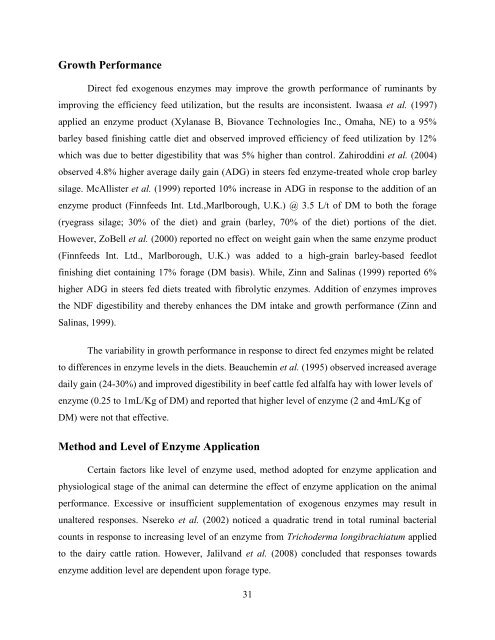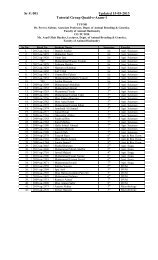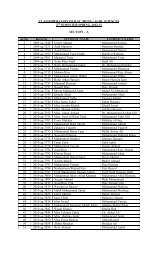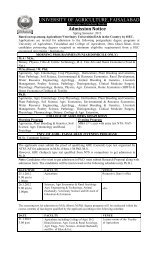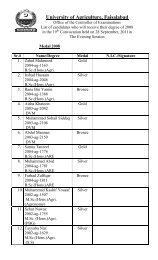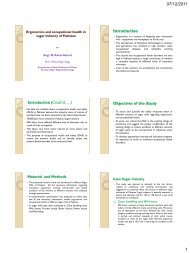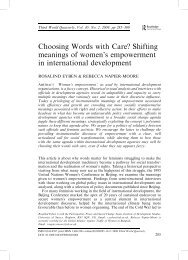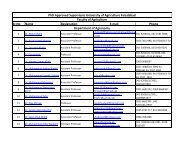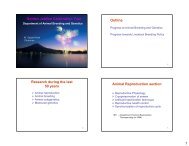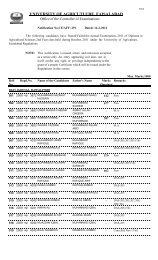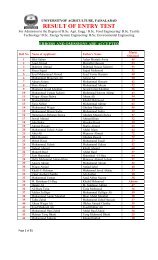Chemical Composition and Digestion Kinetics of ... - icdd@uaf.edu.pk
Chemical Composition and Digestion Kinetics of ... - icdd@uaf.edu.pk
Chemical Composition and Digestion Kinetics of ... - icdd@uaf.edu.pk
Create successful ePaper yourself
Turn your PDF publications into a flip-book with our unique Google optimized e-Paper software.
Growth PerformanceDirect fed exogenous enzymes may improve the growth performance <strong>of</strong> ruminants byimproving the efficiency feed utilization, but the results are inconsistent. Iwaasa et al. (1997)applied an enzyme product (Xylanase B, Biovance Technologies Inc., Omaha, NE) to a 95%barley based finishing cattle diet <strong>and</strong> observed improved efficiency <strong>of</strong> feed utilization by 12%which was due to better digestibility that was 5% higher than control. Zahiroddini et al. (2004)observed 4.8% higher average daily gain (ADG) in steers fed enzyme-treated whole crop barleysilage. McAllister et al. (1999) reported 10% increase in ADG in response to the addition <strong>of</strong> anenzyme product (Finnfeeds Int. Ltd.,Marlborough, U.K.) @ 3.5 L/t <strong>of</strong> DM to both the forage(ryegrass silage; 30% <strong>of</strong> the diet) <strong>and</strong> grain (barley, 70% <strong>of</strong> the diet) portions <strong>of</strong> the diet.However, ZoBell et al. (2000) reported no effect on weight gain when the same enzyme product(Finnfeeds Int. Ltd., Marlborough, U.K.) was added to a high-grain barley-based feedlotfinishing diet containing 17% forage (DM basis). While, Zinn <strong>and</strong> Salinas (1999) reported 6%higher ADG in steers fed diets treated with fibrolytic enzymes. Addition <strong>of</strong> enzymes improvesthe NDF digestibility <strong>and</strong> thereby enhances the DM intake <strong>and</strong> growth performance (Zinn <strong>and</strong>Salinas, 1999).The variability in growth performance in response to direct fed enzymes might be relatedto differences in enzyme levels in the diets. Beauchemin et al. (1995) observed increased averagedaily gain (24-30%) <strong>and</strong> improved digestibility in beef cattle fed alfalfa hay with lower levels <strong>of</strong>enzyme (0.25 to 1mL/Kg <strong>of</strong> DM) <strong>and</strong> reported that higher level <strong>of</strong> enzyme (2 <strong>and</strong> 4mL/Kg <strong>of</strong>DM) were not that effective.Method <strong>and</strong> Level <strong>of</strong> Enzyme ApplicationCertain factors like level <strong>of</strong> enzyme used, method adopted for enzyme application <strong>and</strong>physiological stage <strong>of</strong> the animal can determine the effect <strong>of</strong> enzyme application on the animalperformance. Excessive or insufficient supplementation <strong>of</strong> exogenous enzymes may result inunaltered responses. Nsereko et al. (2002) noticed a quadratic trend in total ruminal bacterialcounts in response to increasing level <strong>of</strong> an enzyme from Trichoderma longibrachiatum appliedto the dairy cattle ration. However, Jalilv<strong>and</strong> et al. (2008) concluded that responses towardsenzyme addition level are dependent upon forage type.31


